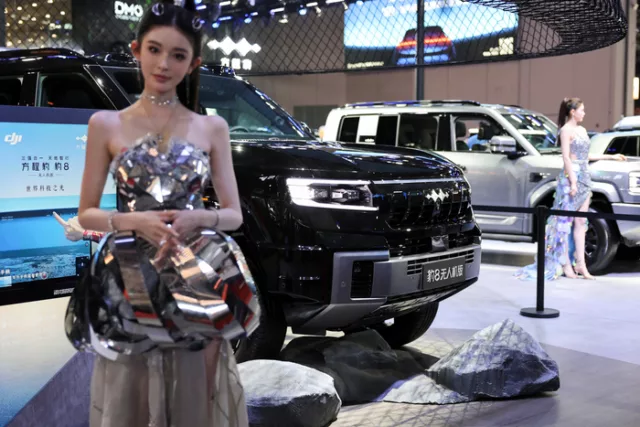![A vehicle introduced by Fanchengbao, a brand affiliated with BYD, China's No. 1 electric vehicle company, is on display at the 20205 Shanghai Motor Show. [Photo source = Reuters Yonhap News]](https://wimg.mk.co.kr/news/cms/202504/27/rcv.YNA.20250424.PRU20250424387401009_P1.jpg)
China, a socialist country where the Communist Party is in power, is one of the leading countries in the world that suppresses its journalists and other media. The People’s Daily of China has become an organ representing the official position of the Communist Party, and as a result, one of the purposes of the media’s existence, «monitoring and criticizing the powerful class,» has disappeared, and the Chinese media has been evaluated as a de facto propaganda tool for the party. After Chinese President Xi Jinping came to power, the principle of «the media is a tool to represent the mouth of the party» was officially established.
Even after the advent of the Internet, the Chinese government’s digital control continued. China has built a Great Firewall, blocked overseas SNS platforms, or censored its own platforms such as Weibo. Citizen journalists who announced the Wuhan crisis in the early days of the pandemic were missing and detained, and since the introduction of artificial intelligence (AI), the subject of censorship has expanded beyond text to images, videos, and voices, leading to «digital totalitarianism.» The Chinese government’s crackdown on the media, including visa controls and deportations, has targeted foreign journalists beyond their own countries.
However, the mood is changing as the Chinese auto industry enters its heyday due to the recent rapid growth. Chinese electric vehicle companies are actively inviting foreign reporters to an event to showcase their new car models. At least hundreds of foreign journalists were invited to the ongoing «2025 Shanghai Motor Show» to cover Chinese-made electric vehicles, reportedly the highest ever. Hundreds of foreign journalists were also reported to have gathered at the corporate event, which was held separately before the official event, to hear the latest model introductions and briefings from Chinese electric vehicle companies such as BYD and Zeekr.
In China, which is famous for strictly controlling foreign journalists as well as its own media, such a change is considered unprecedented. One of the biggest reasons China has transformed into such an «open press» country is the achievement of the goal of reviving its car industry. As it already has the technology, design, and price competitiveness to lead the automobile industry, it plans to actively promote it to the world and significantly increase sales of Chinese electric vehicles in the future.
If the strategy to expand overseas markets is successful, Chinese electric vehicle companies expect that China’s current overproduction of electric vehicles will also be resolved. Sales of electric vehicles from China have reportedly reached about 17 million units this year, while production has more than doubled to about 36 million units a year.
![Crowds flocked to the 2025 Shanghai Motor Show. [Photo source = AFP Yonhap News]](https://wimg.mk.co.kr/news/cms/202504/27/rcv.YNA.20250425.PAF20250425189401009_P1.jpg)
It is reported that the number of foreign journalists visiting China has increased overwhelmingly, especially from Latin America and the Middle East. Analysts say that China’s ambition is to connect the bridgehead for the sale of its electric vehicles, especially in countries where local national income is rapidly increasing. Although Latin America’s electric vehicle market is still suffering from infrastructure shortages such as charging stations, it is expected to grow to $19 billion (about 27 trillion won) by 2030 thanks to government incentives and efforts to expand infrastructure.
BYD, China’s No. 1 electric vehicle company, has invited about 150 journalists and influencer from Latin America, including El Salvador, Paraguay, Ecuador, Chile and Peru. BYD is building a plant in Brazil that can produce 150,000 vehicles annually. MG Motor, a unit of China’s Shanghai Automobile (SAIC), is setting up a factory in Mexico to target the Latin American market.
Beyond foreign correspondents, influencers are also being given more access. This is because influencers who introduce the design and features of new cars that are released every time and attract followers influence consumers’ perception of the quality and performance of automobile brands. Auto YouTuber Forest Jones, who has about 3.2 million subscribers, is also said to have participated in Ziker’s media event in Shanghai, China.
«Right now, most Chinese EV companies are not selling vehicles in the U.S. because of punitive tariffs,» Jones said. «There is no doubt that if Chinese EVs were to be launched in the U.S., U.S. consumers would definitely want to find out what they really are and buy them.»
Beyond EV companies, Chinese EV parts suppliers are now beginning to recognize the importance of media coverage. CATL, the world’s largest EV battery maker, invited hundreds of foreign journalists to its Shanghai factory to showcase its latest innovations at its first «Tech Day» event. CATL is also engaged in an aggressive «pro-media strategy» by inviting influencer Group and others to a test facility near Tesla’s Gigafactory on the outskirts of Shanghai to check the all-in-one chassis of frames, batteries and electric motors to highlight the practicality of its platform.









